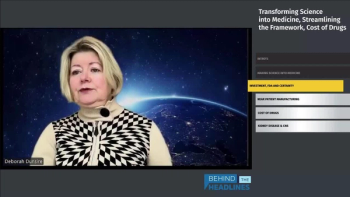
Industrializing Cell and Gene Therapies at Discovery Labs
Joerg Ahlgrimm has left Lonza and is now leading The Discovery Labs’ mission to establish a powerhouse for cell and gene therapy development and manufacturing in the Philadelphia area.
The Discovery Labs is on a quest to become the largest, most technology driven contract development and manufacturing organization (CDMO) in the world. In the process, the company's leaders aim to turn the Philadelphia, PA area into a major force in the global cell and gene therapy (C>) market. Discovery Labs’ “Cellicon Valley” offers C> developers contract services and modern clinical and commercial facilities.
Heading up operations for the Discovery Labs’ Center for Breakthrough Medicines and Testing Centers of America is Joerg Ahlgrimm, who recently left his position as head of global operations at Lonza Pharma & Biotech, to become President and Chief Operating Officer of Discovery Labs.Among his new challenges will be staffing the two centers. Ahlgrimm discussed the move, short and long-term plans, and trends within the cell and gene therapy sector with BioPharm International.
BioPharm: What intrigued you most about working for Discovery Labs?
Ahlgrimm: Previously, I had extremely broad responsibilities. At Lonza, for instance, I oversaw 35 global facilities and all modalities of therapies. I wanted to focus exclusively on C> and help advance and industrialize these treatments to put them on a whole new scale.
After spending more than 20 years at large pharma companies (e.g., Lonza, Baxter, and Schering AG in Germany), I also wanted to work for a startup. The opportunity to work on the East Coast, after spending years on the West Coast and in Switzerland, was also attractive. All of these motives, however, came within the broader umbrella of working in healthcare, and being in a position to help many different people. That has been the overarching motivation.
BioPharm: What do you see as your most important short- and long-term goals at Discovery Labs?
Ahlgrimm: In the short term, I’ll be getting the Center for Breakthrough Medicines and the Testing Centers of America up and running. We need to get the C> center fully operational, build a platform for growth, and work with local, national and international academia and scientific organizations, as well as small innovators and technology companies to advance the manufacturability of C>s.
The goals are clear. We need stable cell lines, better scalability, smaller footprints, better automation.We also need to tighten and intensify processes, to make them more robust and scalable, and to make the products less expensive.
In the long run, what we are building in King of Prussia, PA can accommodate 80 to 120 C> customer development programs at any single point in time. The challenge will be leveraging existing expertise while continuing to build strengths in helping clients move from the discovery phase to Investigational New Drug (IND) applications, from clinical to developmental stages, then on to commercialization and scale-out.The mid- to-long-term goal is not just to create and expand markets for Discovery but for patients to be able to access successful therapies faster.
BioPharm:Speaking of industrialization, what do you see as the main challenges in scale-up and manufacturing, for autologous vs. allogeneic C>s?
Ahlgrimm:On the autologous side, most processes are still extremely manual and they are still coming into the manufacturing space as laboratory-type setups, so they’re really going fresh from the bench to the GMP suite.
Removing human beings from the process, as much as possible, will help us continue the progress that we’ve made so far and sustain momentum.
Autologous processes have already proven themselves, while we have yet to see what allogeneic processes can do, so I do not see autologous therapies being replaced by allogeneics. We must continue to invest in understanding how to make autologous more affordable, and how best to get processes to scale and make them reproducible.
For allogenic processes, scales of up to 2000 L have been achieved. Moving beyond that level is not currently the best way to go.Instead we need to find a way for the majority of C> processes to be scaled up to that level, and to make processes repeatable and reproducible.
BioPharm:How do you see new technology (e.g., in data management, batch management and process control) and supply-chain management advancing C> industrialization?
Ahlgrimm: On the high-volume autologous manufacturing side, the use of systems such as manufacturing execution systems (MES) and electronic batch records (EBR) will help reduce errors and make the manufacturing process more efficient overall.
These systems will need to be connected with logistics solutions that track patient tissues or blood from the time they are taken, into the manufacturing facility, and then back to the patient. This connection will be needed to establish a clear chain of custody, which is the basic requirement for C> processes, but will also improve the speed and efficiency of the end-to-end process.
Another important feature is being able to use all the data that have been created during the overall development process, and in a more advanced way, to be able to find deviations and learn where to improve, continuously.So far, this hasn’t been explored and presents great opportunities, and we will be making strategic investment in this area at Discovery Labs.
BioPharm: Is Discovery Labs exploring the use of artificial intelligence at this point?
Ahlgrimm: AI will ultimately help to make sense out of the enormous amount of data and metadata that will, at one point, become available once C>s are more fully automated.It promises to help developers ‘cut to the chase’ and draw the right conclusions, and be able to adjust processes in real time.
BioPharm:You are charged with hiring nearly 2,000 new staffers for Discovery’s two centers.We keep hearing about a shortage of sufficiently skilled professionals in the C> area. Are you using digital platforms and new technologies (i.e., video, augmented and virtual reality) to train new hires?
Ahlgrimm:We see the digital element as becoming very important in this area because onboarding remains a very labor-intensive operation for manufacturing.We need to be able to train already experienced people (i.e., those who have relevant past experience in biopharm, yet who may not have specifically worked in C> development or manufacturing).
The ability to use Hololens-type technology (i.e., augmented reality) or virtual reality to simulate manufacturing steps will be very important.We need to use those systems and tools to create a training environment in as “real time” a way as possible, without having people enter an actual manufacturing suite.
Onboarding is a key skill to be successful, and newer technology platforms will help.
BioPharm: How has the pandemic changed processes, even within C>, for training and knowledge transfer? Can any lessons be drawn from the challenges that biopharm companies have faced during this period so far?
Ahlgrimm: Clearly, digitalizing more aspects of training and onboarding has helped during the pandemic.However, this trend began before the pandemic, and independently of it.Now, however, the foundation that had been set previously is helping companies meet the challenges posed by the pandemic.
The Discovery Labs will be investing in new tools for onboarding, including virtual and augmented reality.
BioPharm:What types of C> vectors and processes do you expect to dominate in the future?
Ahlgrimm: Adeno-associated virus (AAV) and lentivirus will continue to be the most important ones, as well as standard producer cell lines.
BioPharm:The US Food and Drug Administration just set some guidance earlier in 2020. Which analytical methods to you expect to dominate in quality control for C> quality testing?
Ahlgrimm:Requirements continue to be updated. Every submission and product in development will continue to educate the industry and authorities on what should be used. We can only expect that more will be learned and requirements will change as the field of C> matures. At Discovery Labs, we plan to invest in analytical platforms that can accommodate changing requirements.
BioPharm: Are you seeing any breakthroughs in process equipment customized to work with C> development, scale-up, and manufacturing?
Ahlgrimm: In viral vector manufacturing, there is some focus on optimizing existing technologies.One example is UniverCells’ platform, which has intensified processes so that the footprint can be much smaller.For the most part, though, the process equipment needn’t be all that different from what it is for biopharmaceuticals.
Robotics will be a much more significant differentiator, and is likely to be more dominant in autologous C> than it might have been for biologics or traditional biopharmaceutical manufacturing. For very repetitive processes, automation makes a lot of sense. Some technology developers have begun to work in this area and Discovery Labs will be investing in more automation.
BioPharm: Where do you expect to see future C> centers of excellence, on the global level?
Ahlgrimm:Discovery Labs aims to put the Philadelphia area in the heart of all that, joining Boston, the West Coast, and Texas.In Asia, Singapore and different centers within China will be increasingly important, while Switzerland and the UK are most likely to dominate in Europe.
BioPharm:What do you see as the greatest C> success stories so far, overall and within the narrower framework of “industrialization”?
Ahlgrimm: The greatest success story is the fact that there are now roughly five commercial C> products on the market. Every week there are media reports about new product introductions (e.g. the Novartis therapy that was introduced to treat rare genetic diseases in young children).
For patients, the promise of cell and gene therapies to cure diseases that have been uncurable or even just barely treatable, is coming true.Industry needs to bring more of these therapies to market faster, to make them more affordable and their manufacturing more competitive, but these improvements are now within reach.
On the industrial side, the fact that we can routinely upscale a viral vector to 200 – 500 L standard represents a huge accomplishment. Years ago, we could not even have imagined reaching this point. And now, we are approaching 2000-L batch sizes, as evidenced by C> development projects around the world.
Even with cell therapies, the industry has demonstrated that, despite complex and mainly manual processes, we can produce these therapies.Now we must work on making processes reproducible and much less expensive.Discovery Labs is up to the challenge.
Newsletter
Stay at the forefront of biopharmaceutical innovation—subscribe to BioPharm International for expert insights on drug development, manufacturing, compliance, and more.




